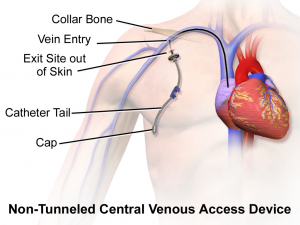A CVC (Central Venous Catheter) is a type of medical device that is used to access the central venous system of a patient. It is typically inserted into a large vein in the neck, chest or groin, and is used for a variety of purposes, such as administering medication, fluids, and blood products, as well as monitoring central venous pressure, hemodynamic status, and blood sampling.
CVCs are commonly used in critically ill patients, particularly those in the intensive care unit (ICU), who require frequent or prolonged venous access. They are also used in patients with difficult peripheral venous access, such as those who are obese or have a history of intravenous drug abuse.
CVCs can be inserted using various techniques, including the percutaneous, the subclavian, the jugular, and the femoral approaches. The choice of approach depends on various factors, such as the patient’s clinical condition, anatomy, and co-morbidities, as well as the operator’s experience and preference.
CVCs can be classified into three main types: non-tunneled, tunneled, and implantable. Non-tunneled CVCs are typically inserted for short-term use, such as for hemodialysis, and are removed once the treatment is completed. Tunneled CVCs are inserted for long-term use, such as for chemotherapy or parenteral nutrition, and are secured under the skin with a tunnel to reduce the risk of infection. Implantable CVCs are also inserted for long-term use and are completely implanted under the skin, with only the access port visible on the surface.
CVCs are associated with various complications, such as infection, thrombosis, bleeding, air embolism, and catheter malposition. The risk of complications can be reduced by following strict aseptic techniques during insertion and maintenance, using appropriate catheter and dressing materials, and monitoring the catheter for signs of dysfunction or infection.
In conclusion, CVCs are an essential medical device for patients who require central venous access for various purposes. They can be inserted using various techniques and classified into different types depending on the duration and purpose of use. CVCs are associated with various complications, and their use requires careful consideration of the patient’s clinical condition, anatomy, and co-morbidities, as well as adherence to strict aseptic techniques and monitoring protocols.



